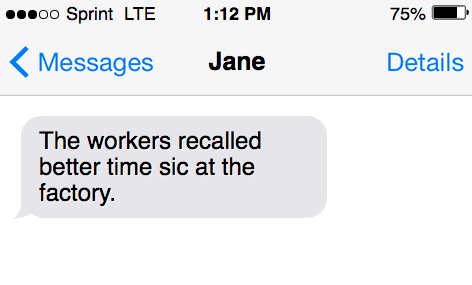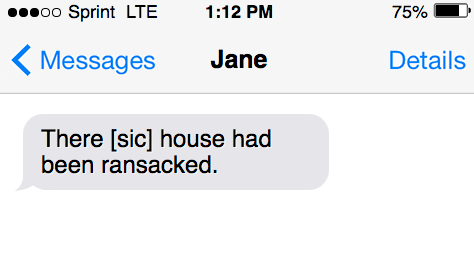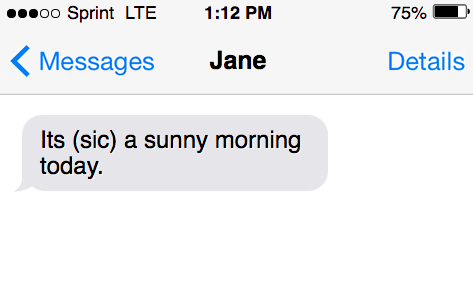What does “sic” mean? Why is it found in articles online or on social media? And what does it mean when someone uses this? Is it an abbreviation for something?
Learn about the use of [SIC] and (SIC) in this short guide…
What does “sic” mean?
Have you ever come across that peculiar expression “sic”? You’ll come across this word occasionally. Especially in news articles and press releases.
According to the definition in Merriam-Webster, the “sic” we come across in quoted text marks indicates either a grammatical or spelling mistake.
In other words, it is used to tell the reader that the text in quotes is verbatim as per the source of information (and not written by the writer itself).
“Sic” is typically used whenever there is a spelling error or grammatical mistake in the quoted text. Also used in situations where it is best to quote the original text, without having to correct the errors.
News articles and press releases are great examples of where this can take place.
Origins of “sic” as a meaning
“Sic” comes from the Latin language, and it literally means “so” or “thus.” It is a shortened form of the Latin phrase “sic erat scriptum” which translates into “thus it is written.”
What are mnemonic devices?
A Mnemonic device or memory device is a learning technique by which complex information or words can be easily remembered using a simpler word. It is an efficient tool that helps in better retention and retrieval from memory.
There are numerous types of mnemonic devices such as acronyms, rhymes, associations, etc. The most common among them are acronyms.
An acronym is nothing but a term coined by gathering the first letter of each word from a group of such words.
Popular examples of acronyms include the following:
RADAR – Radio Detection And Ranging.
LASER – (Light Amplification by Stimulated Emission of Radiation)
GIF – (Graphics Interchange Format)
The expression “sic” is not an abbreviation or acronym, but some people tend to think of it as an abbreviation of “spelled in context.” While this is not true, it can serve as a mnemonic device to remember the purpose of “sic.”
Various ways “sic” can be written
There are three ways to utilize the “sic” expression. Firstly, you can write it enclosed within parentheses (). Secondly, it can get enclosed within square brackets []. And thirdly, you can write it in italicized format and without the parentheses or brackets.
Examples
1) “Its (sic) a sunny morning today.”
In this example, an apostrophe is missing in “Its”. It should have been “It’s”. This is denoted by “sic” within parentheses (sic).

2) “There [sic] house had been ransacked.”
In this second example, the pronoun “their” has been misspelled, and this has been indicated by “sic” within square brackets [sic].

3) “The workers recalled better time sic at the factory.”
In this third example, the right word at the end should have been “times,” and this is marked by “sic” in an italicized form sic.

How to use “sic”
As mentioned earlier, “sic” can get used in a quoted text in 3 ways: within parentheses, within brackets, or in italicized format.
It is important to note that the “sic” expression should get included immediately after the error inside a quoted text.
This is a way of communicating to the reader that the error was intentionally left uncorrected.
Examples in sentences
“The market value of the Toronto Maple Leafs (sic) has simply gone through the roof.
– The Economist, 15 May. 2001”
In this classic example above, the correct name of the famous hockey team is ‘Toronto Maple Leafs’. Despite the plural form of leaf being leaves, the word used in the team name is leafs. To denote this anomaly, “sic” has been put within parentheses immediately after ‘Leafs’.
What does “sic” mean in a quote?
As we have seen earlier, a “sic” within quoted text means that any irregularity or error within the text has been deliberately left uncorrected by the writer.
This was done to quote the original source of the information or text verbatim. Failure to include the “sic” expression may wrongly lead the readers to conclude that the errors were due to the writer’s poor workmanship.
What does “sic” stand for?
“Sic” is a Latin word that literally means “so” or “thus”. It is a shortened way of saying “thus was written”, to indicate the original source of a quoted text or information.
Where does “sic” usually appear?
One can usually find “sic” very often in news articles and press release statements. They also frequently appear in academic writing. Another domain where one can expect to find “sic” expressions very often is social media posts.
These days, the proliferation of social media platforms like Twitter and Facebook has reached its zenith. And it has become common practice for more and more journalists to quote unedited social media posts in their news articles and pieces.
This has resulted in a more pronounced use of the “sic” expression.
Transcribed communication
Of all the practical applications for verbatim recordings, nowhere is it more necessary and relevant than in the transcriptions of courtroom proceedings or legal dispositions.
The final verdicts of legal proceedings have to be recorded verbatim and without any corrections, irrespective of their grammatical integrity.
Another notable application is the recordings of the proceedings inside a parliament or congress. Testimonies of senators and representatives have to get recorded during the hearings and committees.
Hence, these transcriptions invariably have to employ the “sic” expression to quell any ambiguity in the quoted texts.
Transcriptions find common occurrences during shareholders’ meetings conducted by large business enterprises.
Academic writing
Another domain where we can commonly witness the employing of “sic” is the field of academia and academic journals.
Research students and academics often quote original sources and findings while publishing their research papers.
In many cases, they will be required to quote them verbatim. Hence, it is not uncommon to witness the regular use of “sic” in academic journals and research papers.
Social media
Social media is another platform where the use of “sic” is found. It is a surprising and unexpected addition to the list.
This is because it is the polar opposite of the highly formal transcriptions used in courtrooms and congressional hearings.
With more citizens are becoming net-savvy, memes and tweets have become the newfound expressions for the communication of ideas.
Forwards, re-tweets, and shares are happening by the millions, and many of the original creators of posts commit mistakes in their creations. “Sic” can help people who share or forward these posts to dispel accountability for the errors in the posts they had forwarded.
Sources
2) What Does Sic Mean? — An Answer for the ESL Community
3) Memory and Mnemonic Devices
4) Showing Off Your [Sic] Moves
Inside this article
Fact checked:
Content is rigorously reviewed by a team of qualified and experienced fact checkers. Fact checkers review articles for factual accuracy, relevance, and timeliness. Learn more.
Core lessons
Glossary
- Abstract Noun
- Accusative Case
- Anecdote
- Antonym
- Active Sentence
- Adverb
- Adjective
- Allegory
- Alliteration
- Adjective Clause
- Adjective Phrase
- Ampersand
- Anastrophe
- Adverbial Clause
- Appositive Phrase
- Clause
- Compound Adjective
- Complex Sentence
- Compound Words
- Compound Predicate
- Common Noun
- Comparative Adjective
- Comparative and Superlative
- Compound Noun
- Compound Subject
- Compound Sentence
- Copular Verb
- Collective Noun
- Colloquialism
- Conciseness
- Consonance
- Conditional
- Concrete Noun
- Conjunction
- Conjugation
- Conditional Sentence
- Comma Splice
- Correlative Conjunction
- Coordinating Conjunction
- Coordinate Adjective
- Cumulative Adjective
- Dative Case
- Determiner
- Declarative Sentence
- Declarative Statement
- Direct Object Pronoun
- Direct Object
- Diction
- Diphthong
- Dangling Modifier
- Demonstrative Pronoun
- Demonstrative Adjective
- Direct Characterization
- Definite Article
- Doublespeak
- False Dilemma Fallacy
- Future Perfect Progressive
- Future Simple
- Future Perfect Continuous
- Future Perfect
- First Conditional
- Irregular Adjective
- Irregular Verb
- Imperative Sentence
- Indefinite Article
- Intransitive Verb
- Introductory Phrase
- Indefinite Pronoun
- Indirect Characterization
- Interrogative Sentence
- Intensive Pronoun
- Inanimate Object
- Indefinite Tense
- Infinitive Phrase
- Interjection
- Intensifier
- Infinitive
- Indicative Mood
- Participle
- Parallelism
- Prepositional Phrase
- Past Simple Tense
- Past Continuous Tense
- Past Perfect Tense
- Past Progressive Tense
- Present Simple Tense
- Present Perfect Tense
- Personal Pronoun
- Personification
- Persuasive Writing
- Parallel Structure
- Phrasal Verb
- Predicate Adjective
- Predicate Nominative
- Phonetic Language
- Plural Noun
- Punctuation
- Punctuation Marks
- Preposition
- Preposition of Place
- Parts of Speech
- Possessive Adjective
- Possessive Determiner
- Possessive Case
- Possessive Noun
- Proper Adjective
- Proper Noun
- Present Participle
- Prefix
- Predicate



